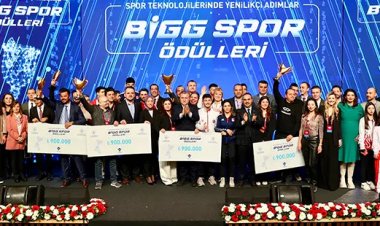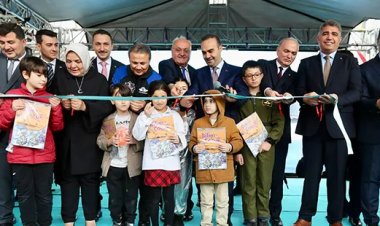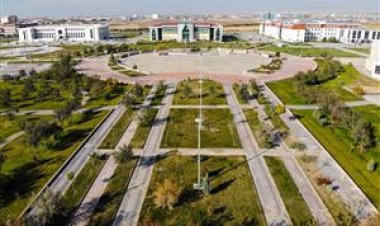Performance analysis of an air solar collector with extended heat transfer surface area with plate fin geometry
Performance analysis of an air solar collector with extended heat transfer surface area with plate fin geometry Amjed, Zeyad Raed Today, most of the energy consumption is provided by coal, oil, and natural gas. These cause many problems such as an increase in greenhouse gas levels, global warming, and environmental pollution. For more countries to meet their commitments to reduce carbon dioxide emissions, the share of renewable energy needs to increase to account for most of the world's energy supply. Solar energy has great potential as an alternative to these fuels. An hour of solar radiation coming to the earth provides enough energy to meet the global energy needs for a full year. Turkey intensively uses solar collectors that generate hot water from solar energy. However, its use in space heating is very limited. Air solar collectors are a kind of heat exchanger that heats the air passing through it with the rays coming from the sun. Since the heat transfer rate to the air is lower than the ratio to the liquid in these systems, it is necessary to increase the heat transfer surface area to eliminate this deficiency. In the project to be done, primarily the air solar collector design will be made and the design will be optimized to provide airflow. A radiator will be used to increase the surface area. This radiator will be cut in appropriate sizes by laser or water jet in a way that will not prevent airflow and will be made suitable for the solar collector design. The design of the obtained system will be made and adapted to the previously determined air solar collector geometry. The resulting radiator geometries will be placed in certain parts of the collector along with the airflow. CFD analysis of the air solar collector with the increased surface area will be made. In these analyzes, the effect of many parameters such as the placement angle of the radiator and the number of radiators on the system performance will be examined. The designed air solar collector will be produced. The necessary materials will be procured and the system will be established. Airflow will be done with the help of a fan. The system will be tested in various weather conditions, at various radiator positions, angles and numbers. In addition, the collector surface will be coated with black paint and selective surface paint, and the effect of these coatings will be examined separately. Finally, the system will be optimized and the air solar collector with an expanded surface area with radiator geometry will be examined economically. Thus, it will be suitable for individual use. Solar energy can be used for domestic or space heating. Where solar energy is sufficient, it will eliminate the fuel cost, and where it is insufficient, it will contribute to the reduction of the fuel cost.; Günümüzde enerji tüketiminin büyük bir kısmı kömür, petrolden ve doğalgazdan sağlanmaktadır. Bunlar sera gazı seviyesinde artış, küresel ısınma ve çevre kirliliği gibi birçok probleme sebep olmaktadır. Daha fazla ülkenin karbondioksit emisyonlarını azaltma taahhütlerini yerine getirebilmeleri için, yenilenebilir enerji payının dünyanın enerji arzının çoğunu oluşturacak şekilde artırılması gerekmektedir. Bu yakıtlara alternatif olarak güneş enerjisinin büyük bir potansiyeli bulunmaktadır. Yeryüzüne gelen bir saatlik güneş radyasyonu, tam bir yıl boyunca küresel enerji ihtiyacını karşılamaya yetecek kadar bir enerji sağlar. Türkiye güneş enerjisinden sıcak su elde eden güneş kolektörlerini yoğun bir şekilde kullanmaktadır. Ancak mekan ısıtmada kullanım çok sınırlıdır. Havalı güneş kollektörleri güneşten gelen ışınlar ile içinden geçen havayı ısıtan bir çeşit ısı değiştiricidir. Bu sistemlerde havaya olan ısı transfer hızı sıvıya oranlara daha düşük olduğundan bu eksikliği ortadan kaldırmak için ısı transfer yüzey alanının artırılması gerekmektedir. Yapılacak tezde öncelikli olarak havalı güneş kollektör tasarımı yapılacak ve hava akışını sağlayabilecek şekilde dizayn optimize edilecektir. Yüzey alanının artırılması için bir radyatör kullanılacaktır. Bu radyatör hava akışını engellemeyecek şekilde lazer ile veya su jeti ile uygun boyutlarda kesilecek ve güneş kollektör tasarımına uygun hale getirilecektir. Elde edilen sistemin tasarımı yapılıp daha önce belirlenmiş olan havalı güneş kollektör geometrisine adapte edilecektir. Elde edilen radyatör geometriler kollektörün hava akışı boyunca belirli bölgelerine yerleştirilecektir. Elde edilen yüzey alanı artırılmış havalı güneş kollektörünün CFD analizi yapılacaktır. Bu analizlerde radyatörün yerleştirilme açısı, radyatör sayısı gibi birçok parametrenin sistem performansı üzerindeki etkisi incelenecektir. Tasarlanan havalı güneş kollektörünün üretimi yapılacaktır. Gerekli malzemeler tedarik edilip sistem oluşturulacaktır. Hava akışı bir fan yardımı ile yapılacaktır. Sistem çeşitli hava koşullarında, çeşitli radyatör konum, açı ve sayılarında test edilecektir. Ayrıca kollektör yüzey siyah boya ve seçici yüzey

Performance analysis of an air solar collector with extended heat transfer surface area with plate fin geometry Amjed, Zeyad Raed Today, most of the energy consumption is provided by coal, oil, and natural gas. These cause many problems such as an increase in greenhouse gas levels, global warming, and environmental pollution. For more countries to meet their commitments to reduce carbon dioxide emissions, the share of renewable energy needs to increase to account for most of the world's energy supply. Solar energy has great potential as an alternative to these fuels. An hour of solar radiation coming to the earth provides enough energy to meet the global energy needs for a full year. Turkey intensively uses solar collectors that generate hot water from solar energy. However, its use in space heating is very limited. Air solar collectors are a kind of heat exchanger that heats the air passing through it with the rays coming from the sun. Since the heat transfer rate to the air is lower than the ratio to the liquid in these systems, it is necessary to increase the heat transfer surface area to eliminate this deficiency. In the project to be done, primarily the air solar collector design will be made and the design will be optimized to provide airflow. A radiator will be used to increase the surface area. This radiator will be cut in appropriate sizes by laser or water jet in a way that will not prevent airflow and will be made suitable for the solar collector design. The design of the obtained system will be made and adapted to the previously determined air solar collector geometry. The resulting radiator geometries will be placed in certain parts of the collector along with the airflow. CFD analysis of the air solar collector with the increased surface area will be made. In these analyzes, the effect of many parameters such as the placement angle of the radiator and the number of radiators on the system performance will be examined. The designed air solar collector will be produced. The necessary materials will be procured and the system will be established. Airflow will be done with the help of a fan. The system will be tested in various weather conditions, at various radiator positions, angles and numbers. In addition, the collector surface will be coated with black paint and selective surface paint, and the effect of these coatings will be examined separately. Finally, the system will be optimized and the air solar collector with an expanded surface area with radiator geometry will be examined economically. Thus, it will be suitable for individual use. Solar energy can be used for domestic or space heating. Where solar energy is sufficient, it will eliminate the fuel cost, and where it is insufficient, it will contribute to the reduction of the fuel cost.;
Günümüzde enerji tüketiminin büyük bir kısmı kömür, petrolden ve doğalgazdan sağlanmaktadır. Bunlar sera gazı seviyesinde artış, küresel ısınma ve çevre kirliliği gibi birçok probleme sebep olmaktadır. Daha fazla ülkenin karbondioksit emisyonlarını azaltma taahhütlerini yerine getirebilmeleri için, yenilenebilir enerji payının dünyanın enerji arzının çoğunu oluşturacak şekilde artırılması gerekmektedir. Bu yakıtlara alternatif olarak güneş enerjisinin büyük bir potansiyeli bulunmaktadır. Yeryüzüne gelen bir saatlik güneş radyasyonu, tam bir yıl boyunca küresel enerji ihtiyacını karşılamaya yetecek kadar bir enerji sağlar.
Türkiye güneş enerjisinden sıcak su elde eden güneş kolektörlerini yoğun bir şekilde kullanmaktadır. Ancak mekan ısıtmada kullanım çok sınırlıdır. Havalı güneş kollektörleri güneşten gelen ışınlar ile içinden geçen havayı ısıtan bir çeşit ısı değiştiricidir. Bu sistemlerde havaya olan ısı transfer hızı sıvıya oranlara daha düşük olduğundan bu eksikliği ortadan kaldırmak için ısı transfer yüzey alanının artırılması gerekmektedir. Yapılacak tezde öncelikli olarak havalı güneş kollektör tasarımı yapılacak ve hava akışını sağlayabilecek şekilde dizayn optimize edilecektir. Yüzey alanının artırılması için bir radyatör kullanılacaktır. Bu radyatör hava akışını engellemeyecek şekilde lazer ile veya su jeti ile uygun boyutlarda kesilecek ve güneş kollektör tasarımına uygun hale getirilecektir. Elde edilen sistemin tasarımı yapılıp daha önce belirlenmiş olan havalı güneş kollektör geometrisine adapte edilecektir. Elde edilen radyatör geometriler kollektörün hava akışı boyunca belirli bölgelerine yerleştirilecektir. Elde edilen yüzey alanı artırılmış havalı güneş kollektörünün CFD analizi yapılacaktır. Bu analizlerde radyatörün yerleştirilme açısı, radyatör sayısı gibi birçok parametrenin sistem performansı üzerindeki etkisi incelenecektir. Tasarlanan havalı güneş kollektörünün üretimi yapılacaktır. Gerekli malzemeler tedarik edilip sistem oluşturulacaktır. Hava akışı bir fan yardımı ile yapılacaktır. Sistem çeşitli hava koşullarında, çeşitli radyatör konum, açı ve sayılarında test edilecektir. Ayrıca kollektör yüzey siyah boya ve seçici yüzey boyası ile kaplanarak bu kaplamaların etkisi ayrıca incelenecektir.
Son olarak sistem optimizasyonu yapılıp radyatör geometri ile yüzey alanı genişletilmiş havalı güneş kollektörü ekonomik yönden incelenecektir. Tasarlanan yüzey alanı genişletilmiş havalı güneş kollektörü ile düşük maliyetli ve daha verimli bir sistem üretilmesi amaçlanmaktadır. Böylece bireysel kullanıma uygun hale gelecektir. Güneş enerjisinin evsel veya mekansal ısıtma amacıyla kullanılması sağlanacaktır. Güneş enerjisinin yeterli olduğu yerde yakıt maliyetini ortadan kaldıracak yetersiz olduğu yerde ise yakıt maliyetinin azalmasına katkıda bulunacaktır.

 Bilgi
Bilgi 













